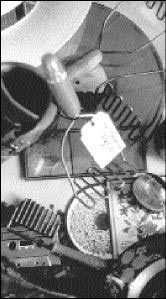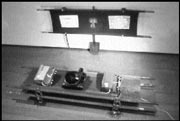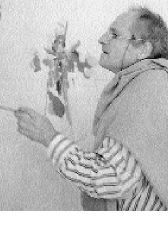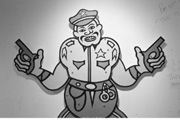1. Accept the fact that art is frivolous. Though you try and try to find intrinsic value in what you’re looking at, this relentless nagging in the back of your mind tells you that it’s all worthless and a waste of time. By accepting the fact that art, as controversial critic Dave Hickey has pointed out, “has no intrinsic value or virtue,” you’re free to take pleasure in simple visual stimulation the way you might enjoy a rock concert, a movie, or a basketball game. Yup, it’s just eye candy.
2. Avoid the obvious. The sidewalk leading from Pioneer Square to the Seattle Art Museum, with a stop-off at the Underground Tour, is worn from thousands of tourists’ feet. The travesty is that many locals tread the same path. Shake the habit! There are neighborhoods as far-flung as Ballard that boast a thriving gallery scene, and former downtown galleries are migrating southward from Skid Road to Georgetown. Cases in point: JEM Studios; the Li’l Red Shack; and the Pound Gallery, Photographic Center Northwest, SOIL, and SAW (Secluded Alley Works). Cut Kulture, a newly opened Belltown gallery, aims to bring “the art of street culture” under its roof.
3. Don’t force an art marathon. Anyone who’s attempted to see every last painting in the Louvre in one stop or even tried to squeeze in too many gallery visits in an afternoon, knows how soon the stomach starts crabbing and the eyes inevitably glaze over. Don’t overload your senses. Take art in small doses. Enter a gallery and linger only at pieces that speak to you. Glide by the others without even stopping. There’s no rule that says you can’t bypass entire rooms if they don’t float your boat. Walk away even if the voice in the headphones is droning on. When your feet hurt and everything looks ugly, get out.
4. Cut the know-it-all crap. This goes for those who do know a thing or two and double for those who don’t have a clue. Don’t be the loudest guy in a quiet gallery expounding upon art history trends and pointing out any and all “cheap tricks” employed by artists. While talking is allowed and encouraged in the gallery setting, your overbearing opinions, broadcast for all to hear, are as invasive as they would be in a darkened movie theater.
5. When in doubt, you’re the expert. If you’re befuddled about the meaning or importance of an art work that seems obscure or looks like a pile of old junk, pretend to be an anthropologist in the field. As you integrate yourself into the local setting, advance your study, firsthand, of its artifacts and rituals. Construct your own analysis of its current social concerns and its repeating patterns. The mental notes you take in the gallery will help you relate this exotic experience to your own people when you return to your homeland—or the office water cooler.
6. Own the art walk. Get out and see and be seen. That’s what first Thursdays are all about. It’s the place to strut your thrift-store couture while catching some high culture—and some stares—on the side. Two fashion alternatives when dressing for the art walk: 1) Go wild in the outfit you wouldn’t dare wear anywhere else, or 2) Make like a critic or high-rollin’ collector. A friend of mine once showed up in a baseball cap and a cashmere overcoat and carried a clipboard while taking copious notes in front of all the most expensive pieces. Gallery owners were on him like white on rice. He was offered private tours, studio visits, the works.
7. Don’t be a slave to the blockbuster. While the big shows at the big museums provide a foundation for art appreciation and provide opportunities to expose townies like ourselves to art that usually resides on the Continent or on the East Coast, these corporate-sponsored nationally touring exhibitions are generally pretty watered down and don’t often offer much in the way of challenging social or political commentary. If anything, they should be used as tools with which to understand and approach exhibitions organized by regional institutions and art by locals. When you do catch blockbuster fever, be sure to poke around while you’re at the museum for smaller, home-grown shows.
8. Reverence the freakshow. One of the perks associated with inserting yourself into an “art” crowd is simply basking in the atmosphere of its ultra-cool glow—or at least its entertainment value from your spot on the periphery. Many artists aspire to Warholian stardom, and there are always some stray, New York-inspired fashionistas to ogle. Swing by the James Harris Gallery and hang with promising young artists who flock there—and catch a glimpse of one of the few men on earth who actually looks like a million bucks in plaid pants (Jim Harris himself). Watch, learn, and promise yourself that you’ll be less boring someday.
9. Party down. If you find the art-walk groupies titillating, just wait till the after-hours crowd shows up. Sedate wine and cheese openings are practically obsolete, and in their place are the real parties, replete with DJs, cash bars, and disco balls. ConWorks puts on some soirees of the highest order, and their reopening bash in November is sure to be a blowout (if all goes smoothly with their renovation at 500 Boren N.). The Seattle Art Museum hosts jazzy bands on Thursday nights and lots of studios open for one-night-only art viewing parties like the SAW Gallery’s upcoming “Night of interactive art at an undisclosed location” (Oct. 12-13).
10. Keep your eyes open. Art is everywhere. Pigs and cockroaches aside, there is art on the street—guerrilla or sanctioned—that we take for granted. Look for Nhon Nguyen’s fabulous paintings in the Metro bus shelters all along the no. 7 route. And, of course, the Henry Moore at the Seafirst building, the Fremont Troll, and James Wehn’s Chief Seattle in Denny Park count, too.







